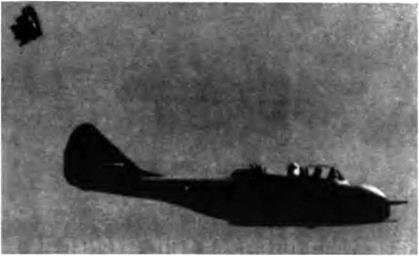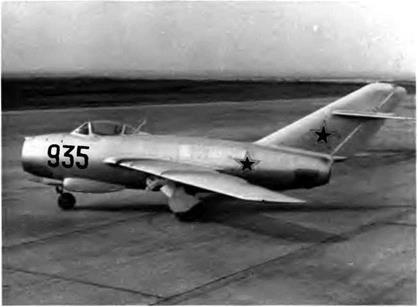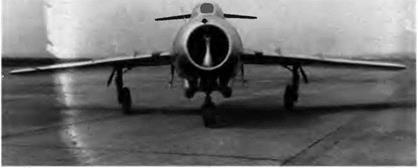The MiG OKB’s first approach to the variable geometry (VG) wing concept dates back to the early 1960s. The countless computations made by the design office showed that VG aircraft could offer an appreciable number of advantages. Many models were built and tested in TsAGI wind tunnels under different flight conditions: takeoffs, landings, and transonic/supersonic speeds. The tests confirmed most of the computations
One of the basic problems the ОКБ had to face in the field of structure as well as aerodynamics was finding just the right place for the wing pivot, and thereby determining the chord and span of the wing. That problem was linked to the optimum pitching stability margin necessary according to the chosen sweep angle, since the shape of the wing as it pivoted and the mean aerodynamic chord were basically dependent on the position of the wing pivot. Another important item involved choosing the proper shape for the fixed wing panels (or gloves) and their wing-to-fuselage junctions. The difficulty there was linked to the distinctive features of the airflow around both the wing and the whole aircraft at great angles of attack in subsonic flight. The shape of the wing’s fixed panels and the blending of their leading edge into the fuselage act extensively upon the vortex flow in these flight conditions; and obviously the vortex flow influences the lift capability and the static pitching stability.
The third hurdle was developing a flight control system capable of changing the wing’s sweep angle and actuating an all-moving stabilator that operated differentially (taileron) plus all the moving surfaces hinged on the wing’s main panels (spoilers and full-span trailing edge flaps). The spoilers were highly efficient at minimum sweep angles, but this efficiency dropped abruptly once the wing was set for a high sweep angle in subsonic flight regime In transonic flight conditions, due to the airflow downwash onto the stabilator caused by their deployment, the spoilers experienced reverse aerodynamic feedback. This is why the roll control had two functions. When the pilot pushed the control column sideways, the spoiler on that side was extended and the opposite half part of the stabilator was deflected.
The spoilers’ extension angle was greatest for the smallest wing sweep angle; as the sweep angle increased, the angle of the spoilers decreased all the way to zero. The slab stabilator operating differentially thus functioned in place of the aileron. To save weight and provide the yaw stability needed over its whole range of speeds, altitudes, and load factors, the aircraft was fitted with a large folding ventral fin (the first of its kind in the world)
Development of the MiG-23 was completed in record time by a group of highly motivated engineers who were never short of ideas, to judge from the number of patents registered as the prototype took shape. The MiG-23 silhouette emerged gradually. The OKB first built an aircraft of a totally different concept It had a fixed delta wing, and its power pack included two lift jets to shorten takeoffs and landings and a primary power plant fed by two lateral air intakes (the first of their kind for a supersonic mixed-power aircraft), clearing space in the nose for the radar. That aircraft was the 23-01. In the course of development, which started in 1964, OKB engineers quickly realized that the lift jets became dead loads after takeoff and that the 23-01 was an uneconomical proposition. When the aircraft was almost completed, Mikoyan grew doubtful about the rationality of the project. Those doubts served as food for thought and were based on several arguments:
— even if the 23-01 could make short landings of 300-350 m (985-1,150 feet), that is, two times less than average, there was always a chance that one or both of the lift jets could fail on final approach
—the space occupied by the lift jets could be better used to house fuel tanks to increase the aircraft’s range
The development of the 23-01 experimental machine was to some extent tied to the customs of the day. At about this time France flight – tested the Dassault Balzac experimental prototype powered by one cruising turbojet and six smaller lift jets. Other countries such as Great Britain and West Germany had also started to design similar machines. The fourteen flights of the 23-01 and the sad end of the Balzac con – finned the pointlessness of the formula.
So another approach was tried: an aircraft powered by a turbojet whose thrust could be vectored at takeoff, in flight, and at landing by swiveling nozzles. The best-known examples are the British Harrier VTOL aircraft and, in the USSR, the experimental Yak-36 and Yak-38 carrier-based combat aircraft, which features both vectored-thrust engines and lift jets—but let us return to variable geometry. The final parameters selected for the wing were minimum sweep angle of 16 degrees, maximum sweep angle of 72 degrees, and leading edge flaps. The advantages of those choices are twofold.
1. Airflow characteristics: high lift-to-drag ratio in supersonic flight conditions due to a high sweep angle and a low thickness-chord ratio and in subsonic flight conditions due to a low sweep angle and a high wing aspect ratio; excellent lift coefficient at takeoff and landing because of a high aspect ratio and the full-span leading edge and trailing edge flaps, good lift-to-drag ratio and lift coefficient at transonic speeds with a midrange sweep angle
2. Flight data: better performance due to peak application of the sweep angle. On that subject it should be noted that the MiG-23 pilot could choose any sweep angle between 16 and 72 degrees, each one presented a distinct advantage for a particular flight regime. Practical experience showed that the three most popular sweep angles were 16, 45, and 72 degrees. Because of its wide – ranging flight envelope, the MiG-23 was undoubtedly one of the best frontline fighters of the 1970s.
As soon as development was halted on the 23-01 VTOL, the highest priority was assigned to the 23-11 VG project. This was further boosted in 1965 by a decree of the ministry of aircraft production that detailed the main specifications: "The MiG OKB is commissioned to design and build a second prototype of the MiG-23 [the first was the 23-01] fitted with a high-lift variable geometry wing. The Rodina MKB [headed by general designer Selivanov] is in charge of designing the wing pivot." The preliminary design was drawn up in a very short time, from January to March 1966. A. A. Andreyev, a very capable designer, was put in charge of the project’s technical management.
The R-27 turbojet was developed especially for the MiG-23 at a time when it was unclear whether the 23-01 or the 23-11 would win out. This is why it was developed and tested concurrently with the two aircraft. It was designed by K. R. Khachaturov as a modification of the R-11F2S-300 twin-spool turbojet, a reliable engine that had powered many of the MiG-21 variants and the whole Yak-28 line.
In the MiG-23 development process care was exercised to automate as many of the pilot’s tasks as possible, especially while intercepting. A. V. Fedotov, newly appointed as the OKB’s chief test pilot, played a dominant part in developing those systems. The 23-11 went for its first flight on 10 April 1967 with this experienced pilot at the controls and the wing at 16 degrees. As early as the second flight two days later, he tested the whole range of sweep angles. The aircraft proved to be easy to control whatever the sweep angle, a quality that triggered Fedotov’s enthusiasm. His log entry for that day reads: "Flight with 16 to 72” sweep angle. It’s a first! Terrific!"
That kind of emotional report seldom appears in a test pilot’s logbook, but admittedly this was a rather unusual case. As early as the third flight, Fedotov broke the sound barrier and continued to accelerate until he reached Mach 1.2 with a 72-degree sweep angle. A few weeks later, on 9 July 1967, the MiG-23 made its public debut with Fedotov at the controls. It was clear after this brilliant display that the 23-11 would be the originator of a great aircraft family—and that was the case, even though the entry into service of such a new aircraft caused some problems of familiarization for pilots (before the delivery of a two-seat trainer to the fighter regiments) and field support crews.
The variable geometry concept was at the heart of some structural innovations. The fuselage structure was organized so that fuel tank no. 2 and the wing center section were as one. It was constructed of welded thin panels made out of VNS-2 alloy. This fuel tank was in fact the aircraft’s primary structure. The stressed box that upheld the wing pivots was attached to that structure, and the air intake duct passed through it. This “wing box-tank” sustained high stress loads at all times and especially during high-g maneuvers. Considering the peculiarity of the aircraft’s missions, the breaking strength of this structure was computed to withstand limit load factors up to 8.
During the factory experiments, state acceptance trials, and military tests, fuel tank no. 2 never caused trouble. And yet. . On 14
March 1972 test pilot A. G. Fastovets had to check the strength of a new type of wing that had a larger area (called the type 2 wing); to do that, he had to reach the limit load factor in pulling out of a long dive. Just as he hit 7.3 g on the accelerometer at 1,000 m (3,280 feet) the tank gave way, and the aircraft totally disintegrated. The pilot was lucky to eject in time.
The subsequent investigation blamed the failure of this primary structural element on cracks that had formed in the panels due to some sort of soot by hydrogen molecules that had found its way onto some of the rough castings. The production factory had to revise the whole of its welding process for the components of fuel tank no. 2 and to inspect all tanks already built. Several cases were reported of wing pivot failure due to the infiltration of hydrogen molecules in welded parts and rotating shafts as well. That problem was overcome by increasing the number of quality checks at every stage of manufacture and by strengthening the structure of the no. 2 fuel tank for all aircraft on the assembly line. For the aircraft already completed, heat carefully applied to the tank structure prevented the hydrogen molecules from spreading and the stresses from accumulating. Moreover, the pivot rotating shafts were made out of a better steel alloy called khromansil.
The area of the type 2 wing was augmented by a chord increase on the leading edge, but it had no leading edge flaps and had been dubbed the "dog-toothed" wing because of the typical shape of the end of its inner leading edge. This enlargement—5.25 m2 (56.51 square feet) at 16 degrees, 4.27 m2 (45.96 square feet) at 72 degrees—resulted in a sweep angle increase at the leading edge. The three most popular angles— 16°, 45°, and 72”—thus became 18”40′, 47°40′, and 74 40’, a constant difference of 2° 40’. But for convenience’s sake it was decided not to modify the figures in the flight manual or on the instrument panel’s sweep angle indicator, which therefore provided erroneous readings.
This enlarged wing would later be fitted with leading edge flaps and named the type 3 wing. The first MiG-23s equipped with that wing appeared in 1973, and from that date all MiG-23s and MiG-27s used it until assembly lines were closed in the early 1980s. The hydraulically driven flaps were added to raise the lift coefficient at great angles of attack. After the basic causes of flow breakaway (resulting in a severe buffeting) were suppressed, it became possible to fly at even greater AOAs. After a great deal of research, engineers developed an automated contrivance to protect against engine surges and flameouts while missiles and cannons were fired.
The more the aircraft was developed, the more the OKB and its client—the air force of the Soviet Army (WS SA)—realized that it had to be upgraded. Its stability, handling characteristics, and maneuverability were significantly improved. It was possible to raise the maxi-
mum operating limit load factor not only by making the airframe sturdier but also by using sweep angle variations intelligently during high-g maneuvers.
The aircraft’s handling characteristics at great AOAs were improved, the pilot helped by new visual and tactile warnings of critical AOAs that could prompt spins. Moreover, the sighting system was improved and the radar was modified so that it could operate in the close-combat mode; simultaneously, the aircraft received a target illuminator to guide semiactive radar homing missiles. New air-to-air missiles optimized for close combat were tested and certified.
In the 1970s a prolific family of attack airplanes based on the MiG – 23 airframe developed. They could cany either bombs or rocket pods, air-to-surface missiles, six-barrel 30-mm guns, and many other frontline air support weapons. With every modification the MiG-23 became lighter. For instance, the takeoff weight of the MiG-23M (1971) was 15,750 kg (34,715 pounds), while for the MiG-23ML (1976) the comparable figure was 14,500 kg (31,960 pounds).
The rapid pace of advances in electronics and optoelectronics made it possible to produce new types of sensors related to outward sight, detection, IFF capabilities, computation of target coordinates, and the like. The power and capacity of the Sapfir radar improved significantly, and ground clutter was cleaned up. The radar was given new operating modes: separation of mobile targets in the lower sector, automatic and simultaneous tracking of several targets, and detection of small ground targets. The MiG-23P’s automatic flight control system (SAU) featured a digital computer unit to control the aircraft’s flight path.
MiG-23s were mass-produced in many versions until the early 1980s and are still operated in many countries, including Russia and the other republics. Today it is widely recognized that the MiG-23 represented an important step in the development of fighter and tactical air command in the USSR.
















